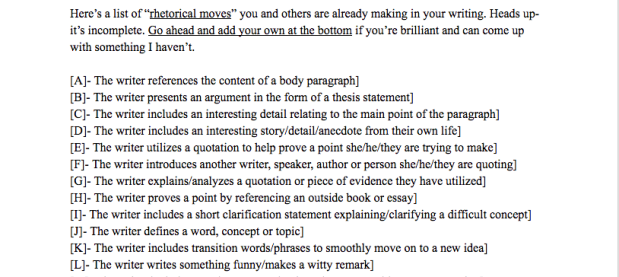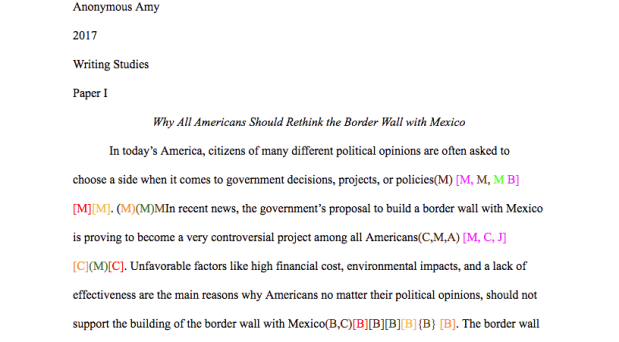Students always benefit from more rhetorical analysis. This is a simple statement that our disciplinary identities, the connotations that automatically form in our brains as rhetoricians and writing teachers, perhaps might function to cloud. What I mean to say here is not that (or not only that) students benefit from more rhetorical analysis assignments being incorporated into the composition curriculum. Rather, what I’d like to spend some time outlining is a specific application and practice that can put into concrete process to enact a statement such as this one. Students benefit from rhetorical analysis, not only as an assignment but more deeply as an action. It’s the difference between a noun and a verb. My concern here is not with the rhetorical analysis assignment many of us assign, but rather with the act, the movement of analyzing, the operation one moves through when one deconstructs the rhetorical moves present in a composition, whether it be visual, sonic or language-based. Without a doubt, my composition courses lately have been leaning more toward the rhetoric in rhetoric and composition. It’s not that the composition aspect has been left out, but rather that my students already largely have this process in their communicational repertoire, as its been distilled in their minds and habits since a young age. Other teachers at previous levels of education have taught my students the composition process. Now, it’s my job to teach them why they do what they’ve been taught to do, and also how to do it more effectively.
I begin my typical semester with a reflection assignment, usually geared around either the class subtopic or on a literacy/social media autobiography. We then move quickly into a rhetorical analysis, likely not very different from what you’ve assigned in your own course. Essentially, what I’m after here is for students to be able to articulate not only what makes for a strong academic resource to use as research, evidence and support for their thesis statement and core argument, but also for them to isolate, identify, and name the specific actions their chosen writers/resources make that demonstrate them to be quality choices for a research project at the college level. Students go through and identify specific moments of ethos, pathos and logos, and then analyze them and explain their significance.
Obviously, this type of assignment is only one way in which to teach rhetoric. There are thousands more. Here, though, I’d like to outline and explain one way that I’ve begun to teach rhetoric retroactively rather than as preparation, which I’ve found many in rhetori and composition tend to do.
My proposal typically take two class sessions to maximize effectiveness and satisfactorily achieve learning outcomes. This is a chronological process. We move both slowly and quickly, both in patient, deliberate practice and in rapid, habit-building succession.

First, we look at Anonymous Amy’s expository research essay that she wrote for me last semester. It uses a thesis statement to build an argument, which Anonymous Amy then supplements with six pages of research, analysis and explanation. Nothing extraordinary here. Anonymous Amy synthesizes her resources and research into a core takeaway: specific changes should be made to our immigration system if we are to cement our identify as a nation of immigrants in the current political and social era.

We begin by referring to a list of 25 “Rhetorical Moves” that I’ve identified. These rhetorical moves are actions students already are taking in their writing — such as introducing and explaining a quotation as a form of evidence, or of introducing and then refuting a disagreeing counterargument — all of which are moves students oftentimes perform without conscious awareness. My goal here is firstly to have students “name” what they do in their writing. We read through Anonymous Amy’s writing, sentence-by-sentence, and we then assign “Rhetorical Moves” that explain exactly what Amy has been doing in her writing. Every sentence requires a justification, an explanation, a strategy.
Each “Rhetorical Move” corresponds to a specific letter, A-W, which students then insert into a shared, collaborative Google Doc. That way, all 23 of us are writing together at the same time. That invites problems, of course, but so long as students are disciplined, the exercise usually goes as planned. Each group of students is assigned a specific color that she/they/him then use to label their annotations and insertions.

For example, the first sentence of Anonymous Amy’s essay is an opening sentence that introduces the basic core of her argument. The sentence corresponds to Rhetorical Move [M] meaning “The writer utilizes a topic sentence that introduces a new topic or conversation,” which the students all generally assign correctly. Others get a lot more difficult. Many and most are open to interpretation.
The true learning moments in this activity tend to be generated in two occurrences:
- When students disagree, or come up with multiple rhetorical moves for a single sentence, or qualify the rhetorical moves they’ve assigned with further analysis and application (they are encouraged to do all of these things).
- When students create their own rhetorical moves. I leave this open-ended. Some students state obvious insights, such as “[X] corresponds to when a writer uses logos
in their writing,” and I don’t discourage this. Others push further: “[X] corresponds to when a writer paraphrases, borrowing the language of someone else to make a point and to provide evidence.”

Disagreement is encouraged here, so long as choices can be labelled, backed up with explanation and compared to the labels of others. Friction generates conversation which generates understanding, awareness and new perspective.
Next, we forgo Anonymous Amy’s paper in favor of the recent Research Papers students have handed in. In this situation, with their writing experience still fresh in their minds, they’re encouraged to justify each and every sentence in their 9-page argumentative essay with not only an explanation, but also a goal, a purpose, a strategy.
The value in this re-frame assignment is in asking students to name their rhetoric. The importance of this has been outlined by Carolyn Miller, among others, and is integral to a rhetorical education in FYC. Naming rhetoric can be useful proactively, as many compositionists tend to outline, typically in the form of assignment requirements and preparation. However, naming rhetoric is equally or more beneficial to a rhetorical education when considered retroactively, after-the-fact. That’s the goal here. That’s the value in a re-frame assignment.
We end class with a freewrite on what we’ve learned about ourselves as writers and rhetoricians from the exercise. This sets us up well for our Writing About Writing project. My composition courses are so loaded with content that we cannot ever waste any time. I find this assignment helpful because it occupies, at most, two class sessions. And it teaches rhetoric, reflection and critical scrutiny as well as any activity I’ve found.

